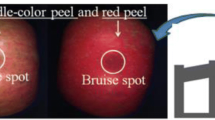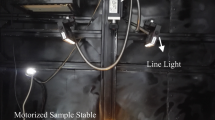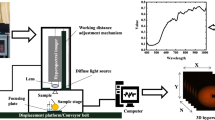Abstract
The quality of yellow peaches was severely reduced due to bruising. Detection of bruised areas in yellow peach is easily disturbed by the calyx and stem ends. Therefore, it is proposed to utilize hyperspectral imaging in conjunction with I-Otsu in the detection of bruise detection in yellow peach after distinguishing between calyx and stem end using curvature-assisted Hough transform circle detection. The band ratio was used to improve the contrast of the images, and the improved Otsu method was used to improve the segmentation accuracy. Noise in the image is eliminated by adaptive median filtering. The effects of the calyx and stem ends are eliminated by curvature-assisted Hough transform circle detection. Spectral bands with valid feature information were selected by principal component analysis and key single-wavelength images (452.8 nm, 608.9 nm, 671.8 nm, 689.4 nm, 825.7 nm, and 966.2 nm) were selected from the loading curves of the spectral regions to create PC images and band ratio images. Band ratio (Q608.9/689.4) images with I-Otsu were used to segment the bruise region. Ultimately, 96% of the bruised yellow peaches were correctly identified. This study demonstrates that hyperspectral imaging combined curvature-assisted Hough transform circle detection and I-Otsu can accurately identify bruised areas as well as calyx and stem ends in yellow peach.













Similar content being viewed by others
Data availability
Data will be made available on request.
References
R. Pandiselvam, S. Sunoj, M.R. Manikantan et al., Application and kinetics of ozone in food preservation. Ozone Sci. Eng. 39(2), 115–126 (2017)
Z. Li, C. Thomas, Quantitative evaluation of mechanical damage to fresh fruits. Trends Food Sci. Technol. 35(2), 138–150 (2014)
P.B. Pathare, M. Al-Dairi, Bruise susceptibility and impact on quality parameters of pears during storage. Front. Sustain. Food Syst. 5, 658132 (2021)
Z. Li, H. Yang, P. Li et al., Fruit biomechanics based on anatomy: a review. Int. Agrophys. 27(1), 97 (2013)
V. Kumar, S.K. Purbey, A.K.D. Anal, Losses in litchi at various stages of supply chain and changes in fruit quality parameters. Crop Prot. 79, 97–104 (2016)
G. Elmasry, M. Kamruzzaman, D.W. Sun et al., Principles and applications of hyperspectral imaging in quality evaluation of agro-food products: a review. Crit. Rev. Food Sci. Nutr. 52(11), 999–1023 (2012)
X. Fu, Y. Ying, H. Lu et al., Comparison of diffuse reflectance and transmission mode of visible-near infrared spectroscopy for detecting brown heart of pear. J. Food Eng. 83(3), 317–323 (2007)
K. Chigwaya, A. du Plessis, D.W. Viljoen et al., Use of X-ray computed tomography and 3D image analysis to characterize internal browning in ‘Fuji’apples after exposure to CO2 stress. Sci. Hortic. 277, 109840 (2021)
R.R. Milczarek, M.E. Saltveit, T.C. Garvey et al., Assessment of tomato pericarp mechanical damage using multivariate analysis of magnetic resonance images. Postharvest Biol. Technol. 52(2), 189–195 (2009)
H.K. Lichtenthaler, G. Langsdorf, C. Buschmann, Multicolor fluorescence images and fluorescence ratio images of green apples at harvest and during storage. Israel J. Plant Sci. 60(1–2), 97–106 (2012)
M.M. Ali, N. Hashim, M.I. Shahamshah, Durian (Durio zibethinus) ripeness detection using thermal imaging with multivariate analysis. Postharvest Biol. Technol. 176, 111517 (2021)
S. Kumar, G.S. Mittal, Rapid detection of microorganisms using image processing parameters and neural network. Food Bioprocess Technol. 3, 741–751 (2010)
X. Sun, C. Xu, C. Luo et al., Non-destructive detection of tea stalk and insect foreign bodies based on THz-TDS combination of electromagnetic vibration feeder. Food Quality Saf. (2023). https://doi.org/10.1093/fqsafe/fyad004
N.K. Mahanti, R. Pandiselvam, A. Kothakota et al., Emerging non-destructive imaging techniques for fruit damage detection: image processing and analysis. Trends Food Sci. Technol. 120, 418–438 (2022)
J. Wieme, K. Mollazade, I. Malounas et al., Application of hyperspectral imaging systems and artificial intelligence for quality assessment of fruit, vegetables and mushrooms: a review. Biosys. Eng. 222, 156–176 (2022)
K. Mantripragada, P.D. Dao, Y. He et al., The effects of spectral dimensionality reduction on hyperspectral pixel classification: a case study. PLoS ONE 17(7), e0269174 (2022)
J. Li, L. Chen, W. Huang, Detection of early bruises on peaches (Amygdalus persica L.) using hyperspectral imaging coupled with improved watershed segmentation algorithm. Postharvest Biol. Technol. 135, 104–113 (2018)
M. Alam, I. Pineda, J.G. Lim et al., Apple defects detection using principal component features of multispectral reflectance imaging. Sci. Adv. Mater. 10(7), 1051–1062 (2018)
W.H. Lee, M.S. Kim, H. Lee et al., Hyperspectral near-infrared imaging for the detection of physical damages of pear. J. Food Eng. 130, 1–7 (2014)
J. Zhang, R. Su, Q. Fu et al., A survey on computational spectral reconstruction methods from RGB to hyperspectral imaging. Sci. Rep. 12(1), 11905 (2022)
W. Huang, J. Li, Q. Wang et al., Development of a multispectral imaging system for online detection of bruises on apples. J. Food Eng. 146, 62–71 (2015)
X. Tian, C. Zhang, J. Li et al., Detection of early decay on citrus using LW-NIR hyperspectral reflectance imaging coupled with two-band ratio and improved watershed segmentation algorithm. Food Chem. 360, 130077 (2021)
H. Wang, R. Hu, M. Zhang et al., Identification of tomatoes with early decay using visible and near infrared hyperspectral imaging and image-spectrum merging technique. J. Food Process Eng 44(4), e13654 (2021)
J. Li, W. Luo, Z. Wang et al., Early detection of decay on apples using hyperspectral reflectance imaging combining both principal component analysis and improved watershed segmentation method. Postharvest Biol. Technol. 149, 235–246 (2019)
S. Yuanyuan, W. Yongxian, X. Guantao et al., Rapid detection of soluble solids content in strawberry coated with chitosan based on hyperspectral imaging. Trans. Chinese Soc. Agric. Eng. 35(18), 245–254 (2019)
X. Cheng, Y.R. Chen, Y. Tao et al., A novel integrated PCA and FLD method on hyperspectral image feature extraction for cucumber chilling damage inspection. Trans. ASAE 47(4), 1313 (2004)
J. Qin, T.F. Burks, M.S. Kim et al., Detecting citrus canker by hyperspectral reflectance imaging and PCA-based image classification method[C]//Defense and Security 2008: Special Sessions on Food Safety, Visual Analytics, Resource Restricted Embedded and Sensor Networks, and 3D Imaging and Display. SPIE 6983, 31–41 (2008)
X. Cao, T. Li, H. Li et al., A robust parameter-free thresholding method for image segmentation. IEEE Access 7, 3448–3458 (2018)
Z. Yao, W. Yi, Curvature aided Hough transform for circle detection. Exp. Syst. Appl. 51, 26–33 (2016)
Y. Sun, I. Pessane, L. Pan et al., Hyperspectral characteristics of bruised tomatoes as affected by drop height and fruit size. Lwt 141, 110863 (2021)
J. Zhang, L. Dai, F. Cheng, Classification of frozen corn seeds using hyperspectral VIS/NIR reflectance imaging. Molecules 24(1), 149 (2019)
A.A. Gowen, R. Tsenkova, C. Esquerre et al., Use of near infrared hyperspectral imaging to identify water matrix co-ordinates in mushrooms (Agaricus bisporus) subjected to mechanical vibration. J. Near Infrared Spectrosc. 17(6), 363–371 (2009)
J. Li, W. Huang, X. Tian et al., Fast detection and visualization of early decay in citrus using Vis-NIR hyperspectral imaging. Comput. Electron. Agric. 127, 582–592 (2016)
J. Li, X. Rao, Y. Ying, Development of algorithms for detecting citrus canker based on hyperspectral reflectance imaging. J. Sci. Food Agric. 92(1), 125–134 (2012)
W. Luo, H. Zhang, X. Liu, Hyperspectral/multispectral reflectance imaging combining with watershed segmentation algorithm for detection of early bruises on apples with different peel colors. Food Anal. Methods 12, 1218–1228 (2019)
Funding
The support by the National Key Research and Development Program of China (No.2022YFD2001804) and National Natural Science Foundation of China (No.12103019) is greatly acknowledged.
Author information
Authors and Affiliations
Contributions
BL: Complete the original draft of the paper. CS: Data processing and analysis. HY: Review of writing. AO: Supervision experimental processes. YL: Financial support, management of research projects.
Corresponding author
Ethics declarations
Competing interest
The authors declare that they have no known competing financial interests or personal relationships that could have appeared to influence the work reported in this paper.
Additional information
Publisher's Note
Springer Nature remains neutral with regard to jurisdictional claims in published maps and institutional affiliations.
Rights and permissions
Springer Nature or its licensor (e.g. a society or other partner) holds exclusive rights to this article under a publishing agreement with the author(s) or other rightsholder(s); author self-archiving of the accepted manuscript version of this article is solely governed by the terms of such publishing agreement and applicable law.
About this article
Cite this article
Li, B., Su, CT., Yin, H. et al. Detection of bruised yellow peach using hyperspectral imaging combined with curvature-assisted Hough transform circle detection and improved Otsu. Food Measure (2024). https://doi.org/10.1007/s11694-024-02541-7
Received:
Accepted:
Published:
DOI: https://doi.org/10.1007/s11694-024-02541-7




